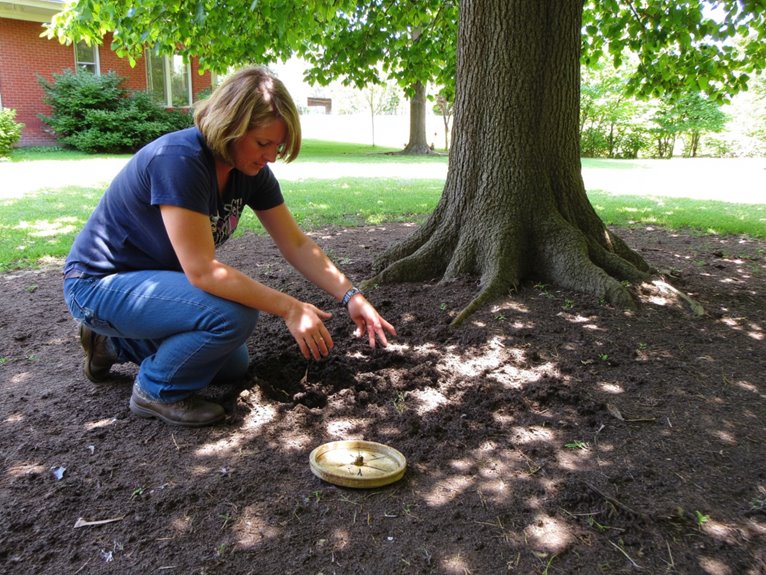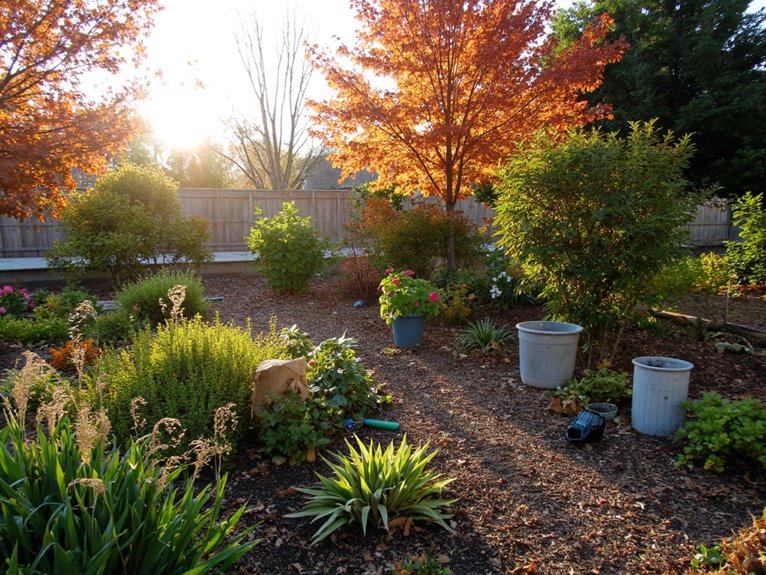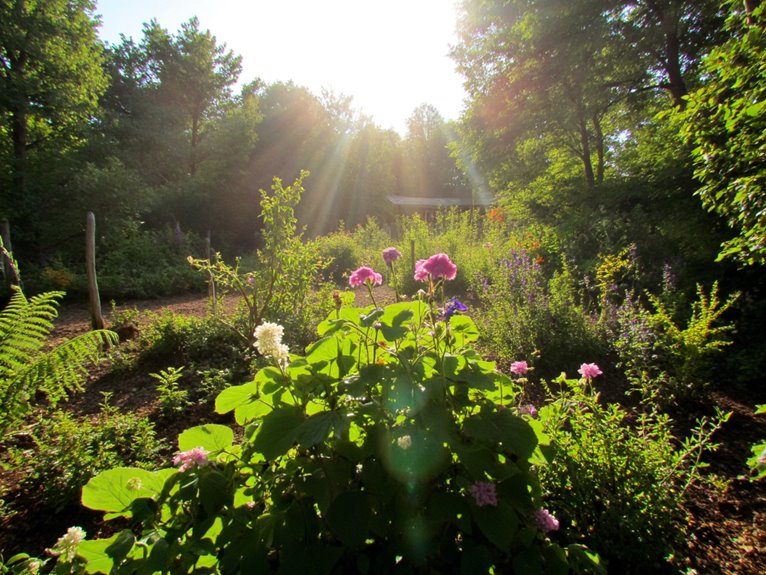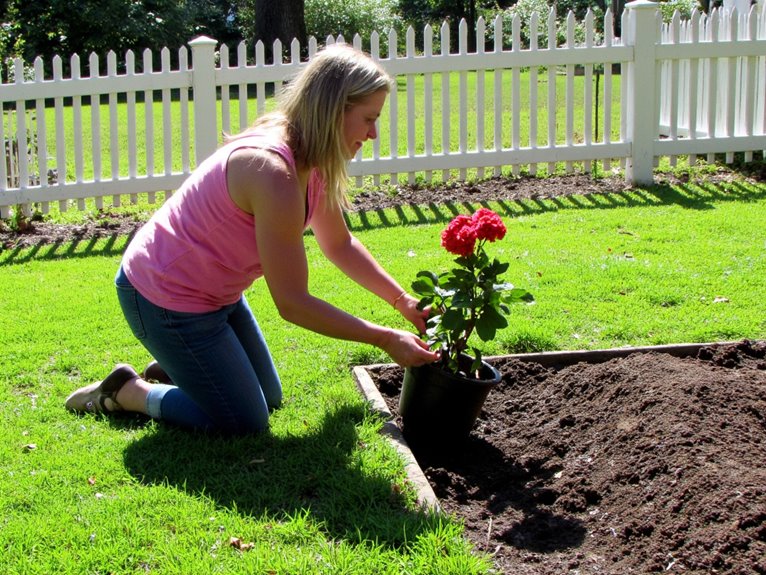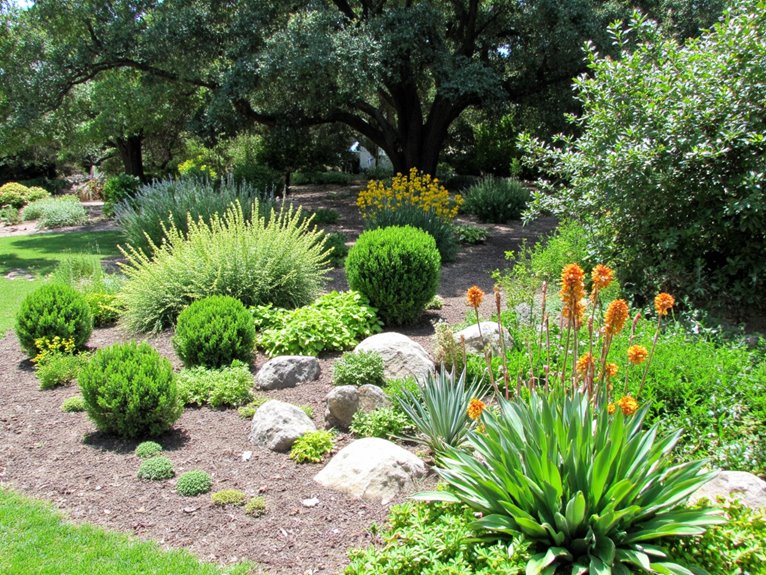Creating Shade Gardens: Designing Plant Spaces for Low Light Growing Conditions
Creating shade gardens starts by understanding your light conditions—full shade needs ferns and hostas, while dappled shade works for day lilies. Test your soil and add organic matter to improve drainage and nutrition. Layer plants strategically: place taller species like azaleas in the middle and low-growing moss at the base. Choose textures and colors that interest the eye even without bright sunlight. With a little thought, you’ll have a peaceful garden space that thrives in the shade—perfect for relaxation and reflection.
Notable Insights
- Assess light levels carefully to match plants like ferns or hostas that thrive in specific shade conditions.
- Improve soil with organic matter for better drainage and nutrient support in low-light areas.
- Layer plants strategically, placing taller species like azaleas above shorter groundcovers such as moss.
- Add seating and lighting to make shade gardens functional and enjoyable spaces for relaxation.
- Choose native plants that naturally adapt to local conditions, reducing maintenance needs in shaded environments.
Understanding Shade Types for Your Garden
Have you ever wondered how a garden can thrive without direct sun? Understanding shade types reveals the secrets of low-light gardening. Full shade areas, getting less than 4 hours of sunlight, need plants like hostas and ferns. Partial shade, with 2–6 hours of sunlight exposure, supports rhododendrons and astilbes. Dappled shade, where sunlight filters through trees, creates dynamic shade patterns perfect for day lilies. Your garden’s aspect—north, south, east, or west—shapes these patterns dramatically. Morning sun offers gentle warmth, while afternoon rays can be intense. Structures like decks or fences also alter shade dynamics. By observing your space’s sunlight exposure and recognizing these patterns, you’ll select plants that flourish in your specific conditions. This knowledge transforms shadowed corners into vibrant garden spaces.
(Recognizing shade patterns helps determine which plants will thrive in different areas of your garden.)
Assessing Soil Conditions in Shade Areas
Once the right plants are chosen for your garden’s light conditions, the next step is to evaluate what’s beneath your feet. Shade areas often have unique soil challenges due to reduced evaporation and slower decomposition. Analyzing soil texture, which affects draination and moisture retention, starts with a jar test or sampling. After gathering soil cores for nutrient analysis and checking pH balance, you’ll better understand how to support root growth. If clay-heavy, adding organic matter can improve structure and drainage. Premium organic mixes that include beneficial elements like mycorrhizae and kelp meal can significantly enhance nutrient uptake and moisture retention in challenging shade garden conditions. Remember, shade effects on soil moisture mean careful watering practices. Don’t forget to test different zones if your garden has varied conditions—your plants will thank you! Selecting native plants that match the specific soil type in shade areas is particularly important, as these plants are adapted to local conditions and require less maintenance.
Choosing the Right Plants for Different Shade Levels
When selecting plants for your garden, matching them to their light requirements is crucial—just as you wouldn’t plant a sun-loving tomato in a perpetual shadow, you must choose species that thrive in your specific shade conditions. Understanding the difference between partial, dappled, full, and deep shade helps create successful plant compatibility. For instance, ferns and Aspidistra excel in deep shade, while Begonias and Caladiums do well in full shade. In dappled shade, plants like Farfugium and Mahonia shine with their unique foliage. Partial shade areas can support Astilbe, Coral Bells, and Liriope.
Seasonal selection also plays a key role in maintaining year-round interest. Choose plants that offer different colors and textures as the seasons change. Pairing plants with similar water and soil needs guarantees they’ll grow together harmoniously. Consider containers with effective drainage systems to prevent root rot in shade gardens where soil may retain more moisture. With careful planning, your shade garden can become both beautiful and abundant. Prioritizing native species not only supports local ecosystems but also ensures better adaptability to regional climate conditions.
Designing With Vertical Layering in Mind
| Layer | Function | Plant Example |
|---|---|---|
| Canopy | Tall structure providing shade | Mature oak tree |
| Understory | Mid-height plants beneath canopy | Ferns, azaleas |
| Groundcover | Low-growing plants at base | Hostas, moss |
This approach not only maximizes light access but also builds habitat diversity and visual interest. For gardeners looking to establish these layered plantings from the ground up, seed starter kits with humidity domes create the controlled environments necessary for germinating shade-tolerant species indoors before transplanting.
Improving Soil Health for Shade Gardens
Building healthy soil for shade gardens starts with understanding that these ecosystems require special care, much like how we would nurture any delicate plant. Compost benefits include improved soil moisture retention, nutrient availability, and enhanced texture—perfect for both clay and sandy soils. Adding several inches of compost annually creates a nurturing base for shade-loving plants. Pair this with mulch to conserve soil moisture and reduce evaporation in shaded areas. Remember to avoid uncomposted materials that can temporarily deplete nutrients during decomposition. By focusing on organic matter and proper hydration, you’re setting your shade garden up for long-term success.
Playing With Color and Texture in Low Light
As you explore shade gardens, think beyond green – the right colors can transform dim corners into vibrant oases. Play with contrasting colors like white astilbe or silvery ferns to brighten shady spots, pairing them with dark greens for depth. Create textured layers by mixing fine-textured ferns with broad hostas, and add interest with glossy abelia or fuzzy coral bells. Contrast delicate foliage with bold leaves, and layer plants by height for dimensional depth. These strategies will turn low-light spaces into visually engaging gardens that sing with color and texture.
Creating Functional Outdoor Spaces in Shade
When it comes to shade gardens, think beyond pretty plants—consider how your outdoor spaces can work for you as well. Functional shade structures like pergolas with climbing vines or louvered roofs offer dynamic outdoor comfort solutions. Add awnings or sun sails to supplement natural shade from trees and hedges. Designate areas for dining, relaxing, or gardening under these covered spaces. Use organic mulch and proper drainage to maintain healthy conditions. Remember that thoughtful placement of plants and structures can transform shaded corners into usable extensions of your home.
Working With Containers in Challenging Shade Conditions
One key consideration is choosing containers that balance function with style—ceramic, wood, or plastic all work if they let water drain freely. For challenging shade conditions, container material selection matters: avoid heavy metals that retain heat. Instead, focus on drainage hole importance, ensuring multiple small holes prevent waterlogging. Large containers offer stability for bigger plants, while smaller ones suit compact arrangements. Repurposed items like tires or boots can add interest if they allow proper drainage. Always use well-draining potting mix and check soil pH regularly. With the right container setup, even low-light spots become thriving gardens.
Enhancing the Garden Experience Beyond Aesthetics
Let’s stretch gardening beyond just looking pretty—think how your space can feel, sound, and even taste like a true retreat. Create multisensory engagement with fragrant herbs like lavender along paths, textured plants for touch, and water features for calming sounds. Edible plants offer taste experiences while deepening connection. These elements support therapeutic benefits, reducing stress and boosting mood through nature’s power. Design secluded nooks for reflection or active areas for exploration based on individual needs. By engaging multiple senses, shade gardens become inclusive retreats that nurture both mind and body in peaceful outdoor spaces.
Frequently Asked Questions
How Do I Prevent Shade Garden Plants From Becoming Leggy?
To prevent legginess, prioritize light exposure by trimming trees for filtered sunlight and maintain nutrient balance with regular fertilization. Avoid overwatering and guarantee air circulation for compact growth.
Can Artificial Lighting Help Extend Growing Conditions for Shade Plants?
Yes, artificial lighting can extend growing conditions for shade plants. The benefits include longer hours and tailored light spectrum. But you gotta consider which wavelengths work best for photosynthesis. Blue and red are key, while lacking full spectrum may cause issues. LEDs offer the most control and efficiency for your shady garden.
What Companion Plants Thrive Together in Low-Light Gardens?
You should pair ferns with hostas and heuchera for lush, layered shade gardens. Combine them with shade flowers like hydrangeas and astilbes for color and texture. These companions thrive together in low-light spaces, offering bold foliage and seasonal blooms that brighten dark corners of your garden.
How Often Should I Divide Shade-Tolerant Perennials?
You should divide shade-tolerant perennials every 2 to 5 years, depending on their growth rate. Check for signs like hollow centers or reduced blooms to know when to divide. Always do it in spring or fall, after flowering but before extreme weather hits.
Are There Specific Pruning Techniques for Shade Garden Plants?
Yes, there are specific pruning techniques for shade garden plants—you need proper pruning to keep them healthy. Remove dead wood, prune before spring growth, and use shears or loppers. This helps with shade garden maintenance by encouraging new blooms and better air flow.
On a final note
As you commence on creating your shade garden, remember that thoughtful design and plant selection can transform even the dimmest corners into thriving, beautiful spaces. With proper soil care, layering techniques, and a focus on plant needs, you’ll enjoy lush growth and year-round interest. Keep learning and experimenting—your garden will thank you for the investment of time and thought.

